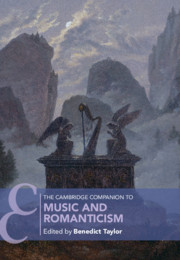Book contents
- The Cambridge Companion to Music and Romanticism
- Cambridge Companions to Music
- The Cambridge Companion to Music and Romanticism
- Copyright page
- Contents
- Figures
- Tables
- Musical Examples
- Contributors
- Preface
- Chronology
- Part I Horizons
- Part II Worlds
- Part III Aesthetics
- 10 Music in Early German Romantic Philosophy
- 11 Meaning and Value in Romantic Musical Aesthetics
- 12 Music and Romantic Interiority
- 13 Music, Expression, and the Aesthetics of Authenticity
- Part IV Practices
- Part V Histories
- Select Bibliography
- Index
- References
13 - Music, Expression, and the Aesthetics of Authenticity
from Part III - Aesthetics
Published online by Cambridge University Press: 06 August 2021
- The Cambridge Companion to Music and Romanticism
- Cambridge Companions to Music
- The Cambridge Companion to Music and Romanticism
- Copyright page
- Contents
- Figures
- Tables
- Musical Examples
- Contributors
- Preface
- Chronology
- Part I Horizons
- Part II Worlds
- Part III Aesthetics
- 10 Music in Early German Romantic Philosophy
- 11 Meaning and Value in Romantic Musical Aesthetics
- 12 Music and Romantic Interiority
- 13 Music, Expression, and the Aesthetics of Authenticity
- Part IV Practices
- Part V Histories
- Select Bibliography
- Index
- References
Summary
This chapter explores the rise of the twin ideals of authenticity and self-expression in Romantic musical aesthetics. Abandoning earlier aesthetic paradigms of mimesis and rhetoric, Romantic musicians were exhorted to bring forth music from the depths of their inner experience. Authentic expression, in this context, depended on the composer maintaining complete autonomy and renouncing the objective of affecting or pleasing an audience. After examining philosophical, social, and economic developments behind this shift in priorities, the chapter argues that expressive authenticity functioned less as a stable quality than as a regulative concept in nineteenth-century musical life. As such, it was often evoked as a way of conferring aesthetic legitimacy and prestige, but was employed in ways that were inconsistent and complex. As examples from nineteenth-century discourses on orchestral timbre, virtuosity, and identity in music show, the ideal of expressive authenticity could function as an effective tool in the creation and reinforcement of hierarchies of power and authority.
- Type
- Chapter
- Information
- The Cambridge Companion to Music and Romanticism , pp. 214 - 228Publisher: Cambridge University PressPrint publication year: 2021



